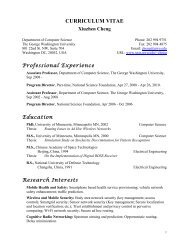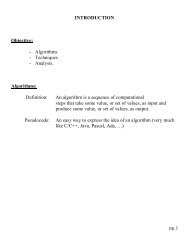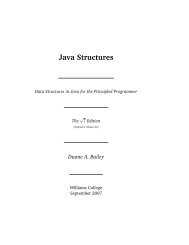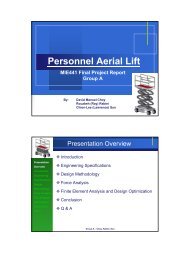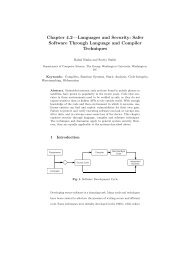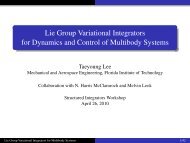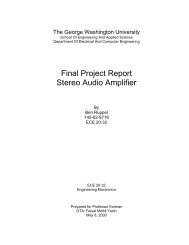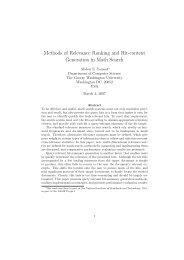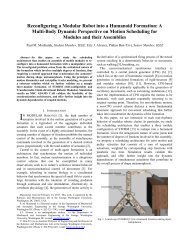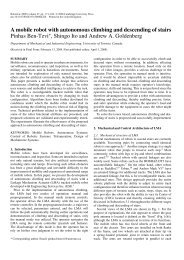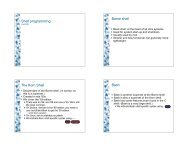Design and Analysis of a Hybrid Mobile Robot Mechanism ... - SEAS
Design and Analysis of a Hybrid Mobile Robot Mechanism ... - SEAS
Design and Analysis of a Hybrid Mobile Robot Mechanism ... - SEAS
You also want an ePaper? Increase the reach of your titles
YUMPU automatically turns print PDFs into web optimized ePapers that Google loves.
Fig. 17 Driving pulley motor torque requirement—inclined<br />
condition<br />
Fig. 16 Link 2 motor torque requirement—step obstacle<br />
climbing with tracks „via Joint 1…<br />
From the top spring array force distribution Fig. 15a, we<br />
observe that the average force in each spring is constant as expected<br />
since they support only the part <strong>of</strong> the track that does not<br />
touch the ground. In this case, the springs act to retain tension in<br />
the track. Also, the forces in the springs supporting the middle<br />
planetary pulley are generally smaller than those located <strong>of</strong>f center,<br />
which is in agreement with the track shape characteristics due<br />
to its bending. Namely, the springs in the center are less compressed<br />
than those <strong>of</strong>f center <strong>and</strong> hence generate less force. The<br />
forces are in the range 0–40 N as the installation compression <strong>of</strong><br />
each spring was 8 mm <strong>and</strong> the optimal spring constant was found<br />
to be 5.19 N/mm.<br />
From the bottom spring array force distribution Fig. 15b, the<br />
force in each spring is fluctuating as expected since it supports the<br />
part <strong>of</strong> the track that touches the ground <strong>and</strong> hence in direct contact<br />
with the obstacle. The forces in all bottom springs are generally<br />
<strong>of</strong> equal range <strong>of</strong> magnitude since none <strong>of</strong> these springs are<br />
free to exp<strong>and</strong> according only with the tracks pliability. In this<br />
case, the forces are greater than 40 N since the springs are compressed<br />
more than the installation compression value due to the<br />
ground’s shape irregularities, which exert additional external<br />
forces on the tracks.<br />
6.3 <strong>Analysis</strong> <strong>of</strong> Motor Torque Requirements. This section<br />
outlines the results <strong>of</strong> additional dynamic simulations performed<br />
in order to calculate the torque required in Joints T 1 , T 2 , <strong>and</strong> T 3<br />
Fig. 8 to propel the tracks, Link 2, <strong>and</strong> Link 3, respectively, for<br />
various mobility scenarios. Once the maximum torque requirement<br />
for each joint was evaluated, proper gear ratios <strong>and</strong> motors<br />
were selected.<br />
Practically, the harshest operating conditions for each motor<br />
will dictate the motor’s selection criteria. An analysis is performed<br />
for each motor in the system by generating torque plots for several<br />
mobility scenarios that require the largest torque capacity. Based<br />
on those torque plots, the maximum peak torque <strong>and</strong> its occurrence<br />
in a given range <strong>of</strong> motion are identified. The peak torque<br />
values define the maximum torque capacity necessary for each<br />
joint.<br />
Figure 16 shows a series <strong>of</strong> motions the different links <strong>and</strong> the<br />
tracks need to undergo in order to climb a 0.5 m step height with<br />
the base link tracks <strong>and</strong> the torque required at every step <strong>of</strong> the<br />
motion. The angular velocity <strong>of</strong> Link 2 30 deg/s was used to<br />
identify the torque at every step <strong>of</strong> the motion with respect to the<br />
angle traveled by the link. According to the torque plot, the torque<br />
peak value for this case occurs at the beginning <strong>of</strong> the motion<br />
T 2 =141.2 N m at t=0. In another analysis similar to Fig. 16, if<br />
the climbing is performed with Link 2 steps shown in Fig. 13e,<br />
a maximum torque value <strong>of</strong> T 2 =141.7 N m was required.<br />
Similar torque analysis procedure was performed to obtain Link<br />
3 motor torque requirement Joint 2 for different scenarios <strong>and</strong><br />
was found to be T 3 =157 N m. For symmetry reasons, we defined<br />
T 2 =T 3 when selecting the motors <strong>and</strong> driving mechanisms for<br />
Links 2 <strong>and</strong> 3. In order to be able to generate the required torques,<br />
Lithium-ion batteries with high drain current capabilities as well<br />
as proper harmonic gearheads <strong>and</strong> brushless DC motors were incorporated<br />
in the design.<br />
When the robot moves on a flat ground or a slope, the driving<br />
torque T 1 Fig. 17 for a single track is determined based on the<br />
condition that slipping does not occur. Therefore, static friction<br />
coefficients were used to estimate the required driving force.<br />
Equation 1 is used in order to estimate the driving force for a<br />
single track. Practically, vibrations <strong>and</strong> impacts occur in the driving<br />
system <strong>and</strong> there are r<strong>and</strong> noises in real-time values <strong>of</strong> F D .<br />
F D s N + W 2 sin = W 2 s cos + sin <br />
To ensure incline motion conditions, the expression to estimate<br />
the torque can be written as follows:<br />
T 1 WR<br />
2 s cos + sin <br />
1<br />
gear k gear track<br />
where F D is the driving force <strong>of</strong> a single track friction force, R is<br />
the outer radii <strong>of</strong> the track, W is the total weight, s is the coefficient<br />
<strong>of</strong> static friction, gear is gear efficiency, k gear is gear ratio<br />
input to output rotational speeds, <strong>and</strong> track is track efficiency.<br />
6.4 End-Effector Payload Capacity <strong>Analysis</strong>. The purpose<br />
<strong>of</strong> this simulation was to identify the maximum allowable endeffector<br />
load capacity <strong>of</strong> the platform with respect to various configurations<br />
by examining the COG vertical movement with respect<br />
to the ground, which indicates tip-over stability. The graph shown<br />
in Fig. 18 describes the change in the robot’s COG position in the<br />
vertical direction with respect to linearly increasing load applied<br />
at the end effector. Among several simulation results based on<br />
various configurations, one possible optimal configuration for this<br />
purpose is shown in Fig. 18. The maximum end-effector load<br />
capacity was found at the instant when the COG position is<br />
greater than zero dashed line in Fig. 18 graph, which indicates<br />
that the COG <strong>of</strong> the robot starts to move up vertically. According<br />
to the graph, the static load capacity with this configuration is<br />
77 kg. Practically, the maximum allowable torque capacity <strong>of</strong><br />
Joints 1 <strong>and</strong> 2 will restrict the actual end-effector load capacity.<br />
Possible selected configurations for manipulation are schematically<br />
presented in Fig. 19. Among the configurations shown in this<br />
figure, some other configurations can be generated in the range <strong>of</strong><br />
the configurations shown, such as vertical or horizontal reach. For<br />
a given torque capacity in Joint 1, configuration c is optimal for<br />
maximum load capacity W p due to its greater tip-over stability. In<br />
each <strong>of</strong> the configurations b, d, <strong>and</strong> e depending on required<br />
level <strong>of</strong> mobility, an end-effector load <strong>of</strong> 18.3 kg is expected<br />
with 157 N m torque capacity in Joints 1 <strong>and</strong> 2. This result is a<br />
direct consequence <strong>of</strong> the novel design architecture, namely, the<br />
1<br />
2<br />
Journal <strong>of</strong> Mechanical <strong>Design</strong> JULY 2008, Vol. 130 / 072302-11<br />
Downloaded 13 Jun 2008 to 128.100.48.224. Redistribution subject to ASME license or copyright; see http://www.asme.org/terms/Terms_Use.cfm



